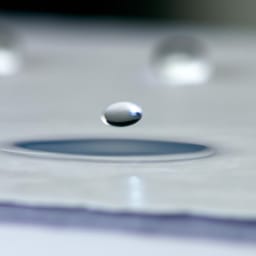Water has a high surface tension due to the strength of the hydrogen bonds between molecules of water. This strong force allows water molecules to stick together and form a surface that is difficult to penetrate. As a result, water can form droplets and maintain its shape when poured onto a flat surface, giving it its characteristic high surface tension.Surface tension is the elastic tendency of a liquid’s surface that allows it to resist an external force. It is caused by intermolecular forces between molecules of the same substance and is responsible for the shape of liquid droplets. Surface tension also affects the behavior of small particles on a liquid surface, such as oil droplets floating on water.
What Causes the High Surface Tension of Water?
Water molecules have a high surface tension due to their strong hydrogen bonds. These hydrogen bonds form when the negative oxygen atom of one water molecule interacts with the positive hydrogen atoms of another molecule. This creates an attractive force between them, which results in the molecules being pulled closer together. This creates a kind of “skin” on the surface of the water, which allows it to resist changes in shape and keeps objects on its surface from sinking. The strength of these hydrogen bonds is what gives water its high surface tension, as they are much stronger than other forces such as van der Waals forces. Additionally, water molecules are also attracted to each other due to their dipole-dipole interactions, further increasing the surface tension.
The high surface tension also plays an important role in the ability of water to move up narrow tubes or capillary action. The combination of the strong forces between water molecules and their ability to form a continuous film on surfaces allows them to move through very small spaces where other liquids cannot go. This is why you often see plants with roots that can penetrate deep into soil and rocks – because water has a high surface tension, it can cling to surfaces and move up against gravity in narrow spaces.
Water Molecule Contribute to the High Surface Tension
Water molecules are naturally attracted to each other and form strong bonds. This is known as cohesion, and it causes water molecules to form a surface that is rather elastic and resistant to penetration. This is what gives water its high surface tension. The strength of the bonds between the water molecules on the surface of a body of water is greater than the forces between the molecules below it. This causes the surface of a body of water, such as a lake or ocean, to act like an elastic film, giving it its high surface tension.
The attraction between the molecules on the surface is so strong that it can actually support light objects such as insects or even small pieces of paper. Water’s high surface tension also allows it to hold together when poured from one container into another, and this contributes to its ability to clean surfaces by “beading” up dirt and grime for easy removal.
High surface tension in water also makes it an effective tool for protecting plants from disease-causing organisms, like fungi and bacteria, which cannot penetrate through water’s elastic film easily. The presence of this film on plant leaves prevents them from getting infected with these pathogens. In addition, because of its high surface tension, water can resist freezing temperatures better than any other liquid, allowing it to stay liquid longer at lower temperatures.
How Does Temperature Affect Water’s Surface Tension?
Surface tension is the result of unbalanced intermolecular forces between molecules of a liquid. Water is a polar molecule, meaning it has both positive and negative ends, and these ends attract each other. This attraction creates surface tension on the surface of the water. Temperature can affect the surface tension because heat energy increases the kinetic energy of the molecules, causing them to move faster and break apart from their attractions. As temperature increases, the surface tension of water decreases. This phenomenon is known as thermal expansion, which is when a substance expands in volume when heated and contracts in volume when cooled. The greater the temperature difference between two regions, the more pronounced this effect will be on water’s surface tension. Since warm water has lower surface tension than cold water, it can more easily form droplets or bubbles that are not supported by an interface with air or another solid material.
The effects of temperature on water’s surface tension can be seen in everyday life. Hotter baths have less bubbles because they have lower surface tensions than cold baths. This also explains why some insects, like water striders, are able to walk on a thin film of water – they take advantage of higher temperatures to reduce its surface tension so they can move more easily across its surface without breaking through it. Additionally, this phenomenon can be used to predict how quickly certain liquids evaporate at different temperatures as lower surface tensions make them easier to vaporize into gas form.
In summary, temperature affects water’s surface tension by increasing its kinetic energy which causes it to reduce its intermolecular attractions and expand in volume. Lower temperatures lead to higher surface tensions while higher temperatures result in lower ones. This effect can be seen in everyday life from bubble formation in baths to insect movement on thin films of water as well as how quickly certain liquids evaporate at different temperatures.
What Factors Affect Water’s Surface Tension?
Water’s surface tension is affected by a variety of factors including temperature, salinity, pH, and the presence of surfactants. Temperature has a direct effect on water’s surface tension; as the temperature increases, the surface tension decreases. Salinity also affects water’s surface tension; as the salinity increases, so does the surface tension. pH has an indirect effect on water’s surface tension; as the pH increases, so does the hydrogen ion concentration which reduces the surface tension. Finally, surfactants can have a significant effect on water’s surface tension; they reduce it by disrupting the hydrogen bond network at water’s interface.
In summary, temperature, salinity, pH and surfactants can all affect water’s surface tension. Temperature and salinity have a direct effect whereas pH and surfactants have an indirect effect. It is important to understand these factors when working with water in order to ensure that it behaves as expected in different environments.

How Does Soap Lower Water’s Surface Tension?
Soap is a surfactant, meaning it has the ability to lower the surface tension of water. This is due to the molecules of soap having one end that is attracted to water and another end that is not. The molecules form a thin film over the surface of the water and reduce the tension between the molecules. This makes it easier for water molecules to move around and break up any surface tension that exists. When there is less surface tension, it allows other substances such as dirt or oil to be washed away more easily. Additionally, this also allows soap bubbles to form which are stable due to their low surface tension.
Surface tension occurs when a liquid molecule’s attraction for other liquid molecules is greater than its attraction for air molecules. This causes a layer of liquid molecules at the top of a body of water which creates an invisible film known as surface tension. Soap works by breaking down this film and lowering its surface tension, allowing other substances to be washed away more easily. By reducing the amount of surface tension that exists in water, soap helps increase its cleaning capabilities.
High Surface Tension Properties of Water
Water’s high surface tension is a physical property that results from the strong interactions between water molecules. This property is responsible for a number of phenomena, including the ability of insects to walk on the surface of water. Other properties that depend on water’s high surface tension include its low compressibility, its higher density than other liquids, and its higher boiling point than most other liquids.
Water’s high surface tension also affects the behavior of some organisms. For example, some species of water striders and diving beetles are able to walk on the surface of water due to their body structures and the way they interact with the water molecules at the surface. This phenomenon is known as “hydrophobic walking”.
The high surface tension also gives rise to capillary action, which helps liquid move through narrow passages or through porous materials such as paper towels or soil particles. The strong forces between molecules in the liquid pull them up against gravity, causing them to move through small spaces. This is why plants are able to absorb water from their roots into their stems and leaves; they take advantage of capillary action by using their roots as small pumps.
Water’s high surface tension affects its other physical properties as well, such as its low compressibility and higher density than other liquids. The strong forces between molecules prevent them from being compressed easily, making it difficult for air bubbles to form in it under pressure. Its density means that it is heavier than most other liquids; this makes it more difficult for objects to float in water compared to other liquids such as oil or alcohol. Finally, due to its strong intermolecular forces, water has a significantly higher boiling point (100°C) than most other substances (such as ethanol with a boiling point of 78°C).
Overall, these properties are all related and result from water’s unique physical structure and strong intermolecular forces. These properties make it an important substance for living organisms in many environments and explain why it can be found in so many different forms in nature.
Surface Tension and Aquatic Organisms
Surface tension, or the force that causes a liquid to act as if it has a skin on its surface, is an important factor in aquatic environments. This force is caused by the cohesion of molecules at the surface of the water. High surface tension makes it difficult for organisms to move across the water’s surface and can also prevent them from accessing food sources. This can significantly impact their ability to survive and thrive in their environment.
High surface tension can also affect respiration in aquatic organisms. Oxygen levels are lower at the surface of a body of water due to the high surface tension, which makes it difficult for air to penetrate down into deeper parts of the water. As a result, aquatic organisms may not be able to access enough oxygen through their gills, causing them difficulty in breathing and swimming.
High surface tension can also affect reproduction in aquatic organisms. Many species rely on external fertilization for reproduction, which requires eggs and sperm to be released into open water so they can encounter one another. High surface tension makes it difficult for eggs and sperm to stay suspended in open water long enough for fertilization to take place, thus reducing reproductive success.
The effects of high surface tension on aquatic organisms are numerous and significant. By limiting access to food sources, inhibiting respiration, and reducing reproductive potential, high surface tensions can have severe negative impacts on an organism’s ability to survive and thrive in its environment.

Conclusion
Water has a high surface tension because of the cohesive forces between its molecules. These cohesive forces are produced by hydrogen bonds that form between oxygen and hydrogen atoms in the water molecules. This property of water allows it to form droplets, which have many useful applications in everyday life. Water’s high surface tension also makes it possible for some aquatic animals to move easily on the surface of water.
Overall, the high surface tension of water is an important property that has both practical and scientific significance. Its unique characteristics make it one of the most important substances on Earth and give us a better understanding of how molecules interact with each other.

